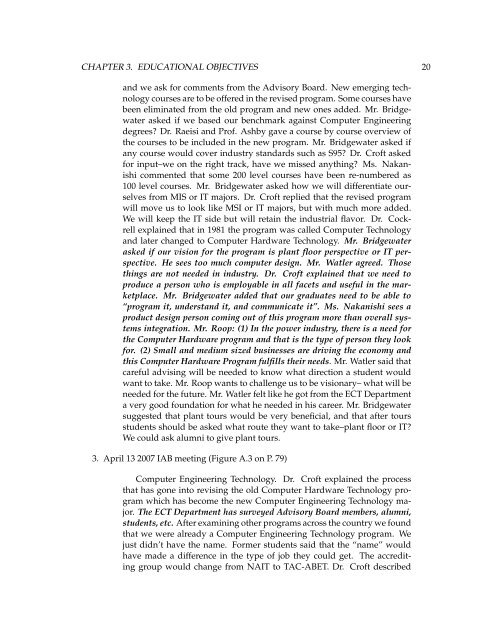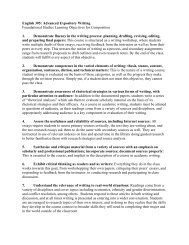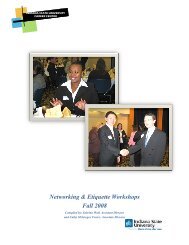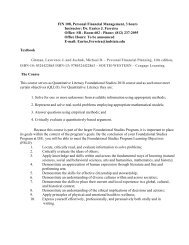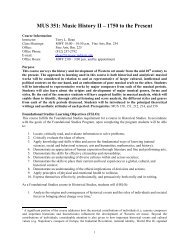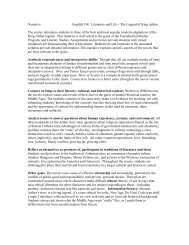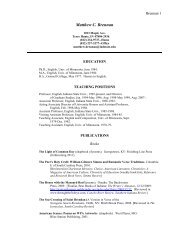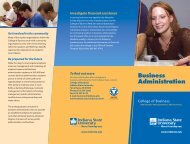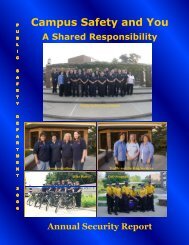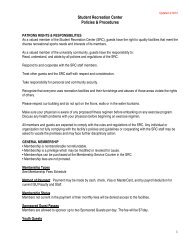CET - ABET Self-Study - Indiana State University
CET - ABET Self-Study - Indiana State University
CET - ABET Self-Study - Indiana State University
Create successful ePaper yourself
Turn your PDF publications into a flip-book with our unique Google optimized e-Paper software.
CHAPTER 3. EDUCATIONAL OBJECTIVES 20<br />
and we ask for comments from the Advisory Board. New emerging technology<br />
courses are to be offered in the revised program. Some courses have<br />
been eliminated from the old program and new ones added. Mr. Bridgewater<br />
asked if we based our benchmark against Computer Engineering<br />
degrees? Dr. Raeisi and Prof. Ashby gave a course by course overview of<br />
the courses to be included in the new program. Mr. Bridgewater asked if<br />
any course would cover industry standards such as S95? Dr. Croft asked<br />
for input–we on the right track, have we missed anything? Ms. Nakanishi<br />
commented that some 200 level courses have been re-numbered as<br />
100 level courses. Mr. Bridgewater asked how we will differentiate ourselves<br />
from MIS or IT majors. Dr. Croft replied that the revised program<br />
will move us to look like MSI or IT majors, but with much more added.<br />
We will keep the IT side but will retain the industrial flavor. Dr. Cockrell<br />
explained that in 1981 the program was called Computer Technology<br />
and later changed to Computer Hardware Technology. Mr. Bridgewater<br />
asked if our vision for the program is plant floor perspective or IT perspective.<br />
He sees too much computer design. Mr. Watler agreed. Those<br />
things are not needed in industry. Dr. Croft explained that we need to<br />
produce a person who is employable in all facets and useful in the marketplace.<br />
Mr. Bridgewater added that our graduates need to be able to<br />
“program it, understand it, and communicate it”. Ms. Nakanishi sees a<br />
product design person coming out of this program more than overall systems<br />
integration. Mr. Roop: (1) In the power industry, there is a need for<br />
the Computer Hardware program and that is the type of person they look<br />
for. (2) Small and medium sized businesses are driving the economy and<br />
this Computer Hardware Program fulfills their needs. Mr. Watler said that<br />
careful advising will be needed to know what direction a student would<br />
want to take. Mr. Roop wants to challenge us to be visionary– what will be<br />
needed for the future. Mr. Watler felt like he got from the ECT Department<br />
a very good foundation for what he needed in his career. Mr. Bridgewater<br />
suggested that plant tours would be very beneficial, and that after tours<br />
students should be asked what route they want to take–plant floor or IT?<br />
We could ask alumni to give plant tours.<br />
3. April 13 2007 IAB meeting (Figure A.3 on P. 79)<br />
Computer Engineering Technology. Dr. Croft explained the process<br />
that has gone into revising the old Computer Hardware Technology program<br />
which has become the new Computer Engineering Technology major.<br />
The ECT Department has surveyed Advisory Board members, alumni,<br />
students, etc. After examining other programs across the country we found<br />
that we were already a Computer Engineering Technology program. We<br />
just didn’t have the name. Former students said that the “name” would<br />
have made a difference in the type of job they could get. The accrediting<br />
group would change from NAIT to TAC-<strong>ABET</strong>. Dr. Croft described


